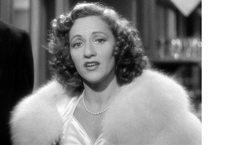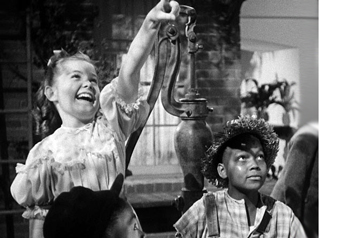
 |
|
|
|
Fans of vintage jazz will gravitate immediately to the Cohen Film Collection's Blu-ray and DVD releases of Syncopation, an unusual 1942 experiment in musical filmmaking. Like some other German film directors that emigrated in the 1930s, producer-director William Dieterle was fascinated by American culture. Looking for something new, he attempts to tell the story of the American musical art form that even in 1942 was probably appreciated more widely in Europe than here in the States. Syncopation has a story of sorts, but it serves only as a way of holding together its music performances. The project may also have been inspired by Disney's semi-experimental Fantasia of a couple of years previous. With its
Syncopation looks and sounds expensive, with many large sets, crowd scenes and complex visuals; several sequences resemble themed music videos from forty years later. I don't know if music experts would approve of the choices in the almost wall-to-wall music, which is supposed to represent the development of the jazz form. There are no big radio hits, which is a good sign. The show finishes off with a big swing number, offering glimpses of some big names: Charlie Barnet, Benny Goodman, Harry James, Jack Jenney, Gene Krupa. They're identified as the "All American Dance Band." Noted singer Conee Boswell (picture immediately below) warbles one of the few vocal solos, singled out for special attention. 
The story, such as it is, follows Kit Latimer (Bonita Granville), a Southern girl raised around black servants, and whose best friend is little Rex Tearbone (as an adult, Todd Duncan), a talented trumpet player and the son of her maid Ella (Jessica Grayson). Rex pretends to be 'Gabriel's horn' at a church meeting, and is so good that King Jeffers (Rex Stewart) offers him a job in his Dixieland band. Kit is upset when her father George (Adolphe Menjou) moves to Chicago to invest with businessman Steve Porter (George Bancroft). She's intended for Porter's son Paul (Ted North) but falls in with the spirited, homeless trumpet player Johnny Schumacher (Jackie Cooper) and music fan/promoter Smiley Jackson (Frank Jenks). Kit's piano playing causes such a commotion that she's briefly put on trial -- in 1915, the word 'jazz' was synonymous with the F-word. George refuses to allow Kit to play professionally, but she helps Johnny get connected. When Johnny meets the now-grown Rex, up from New Orleans, both of their careers take off.
Syncopation surely won't attract praise for doing what most mainstream movies do, which is tell a story about black performers and black history from a white point of view. The movie is packed with
Yet Syncopation is a progressive film. In 1942, just having black actors interacting with whites in non-servile roles was a big step forward; Cabin in the Sky and Green Pastures were all-black affairs. In this fantasy racial prejudice doesn't exist. Johnny Schumacher walks up to Rex's bandstand and is immediately invited to sit in on a session. Rex even calls him, 'boy', just as if the audiences in ten thousand Southern theaters wouldn't take offense. But there's a telltale fly in the ointment: when Rex loans Johnny a trumpet, he lets everyone know that the horn is brand-new. The only reason to include that detail is to assure viewers that white and black lips won't be sharing the same mouthpiece. But Syncopation doesn't play like typical race-constipated Hollywood product of the time. Dieterle begins with a sequence in Africa, showing a trader unloading a box of iron chains, with a dissolve to natives being loaded into the hold of a ship. That had to be a first for RKO. Bonita Granville and Jackie Cooper are sweet to look at. Cooper is essentially playing Bix Beiderbecke, but without the emotional turmoil of the 1950 Kirk Douglas movie Young Man with a Horn. Rex passes on his jazz genius to Johnny, just as the movie implies that white-bread swing is some kid evolutionary step beyond from black-sourced jazz. 
Versatile William Dieterle had directed German silents and acted for Murnau. He came to Warners almost at the beginning of sound. Considered a highly refined visual stylist, he made pictures like The Last Flight, A Midsummer Night's Dream and the Charles Laughton The Hunchback of Notre Dame. The scene transitions in his Juarez are tailored to fit composer Erich Wolfgang Korngold's thundering music. Syncopation's visuals employ superimpositions and associative cuts to enliven its frequent musical numbers. The film doesn't stoop to teach the audience to appreciate jazz , but it does achieve some sublime moments. Rex silences his orchestra in the middle of a dance number, letting his ballroom patrons dance for a few seconds to the sound of their own feet. There's a lot of creative cutting going on. The editor was future director John Sturges, who enlisted in the Army as soon as he finished this show. The odd titles appear to be written in sand; I'm not sure what the connection is, unless it's the sand of an African beach in the slave trade. Dieterle's previous film The Devil and Daniel Webster was equally 'arty', and Syncopation may have been the last gasp of directorial stylization before RKO studio policy turned against self-conscious 'genius' work in the wake of the Citizen Kane debacle. The very last scene can boast what might be an editorial first. Gene Krupa's final drum flourish ends with a shock cut to a black, silent screen ... followed a couple of seconds later by a fade-up of the RKO logo. Take that, French New Wave. 
Syncopation plays well enough considering that its entire narrative is meaningless nonsense. The idea seems to be to show jazz music's relationship to the culture from the years 1905 to 1942, but there are no specific names, dates or timeless songs used in the story. The movie will nevertheless be a welcome curiosity to music fans. What it does show is that even under commercial restraints and the Production Code, Hollywood filmmaking could produce highly innovative, even experimental work. Syncopation is 90 minutes of very pleasing musical diversion. Cohen Film Collection's Blu-ray of Syncopation is a flawless encoding of this ultra-rare feature, released and then abandoned by RKO in 1942. It's likely that the film was in production before Pearl Harbor; the timing wasn't perfect for a reflective movie about our black music heritage. However Raymond Rohauer happened to acquire the rights from RKO -- no outside production entity is credited -- the elements have been maintained in perfect shape, with robust audio.
Rohauer evidently scooped up the rights to a number of Paramount musical shorts from the early 1930s as well. As some were in
A very thin Louis Armstrong sings "I'll Be Glad When You're Dead You Rascal You" and "Just Because" in 1932's Rhapsody in Black and Blue. Symphony in Black (1935) is the first of three shorts with Duke Ellington; this one has a too-brief sequence of Billie Holiday singing. In 1933's Bundle of Blues Duke accompanies singer Ivy Anderson, and the dance team of Florence Hill and Bessie Dudley. Black and Tan Fantasy from 1929 features Duke Ellington's compositions "The Duke Steps Out" and "Black Beauty". The first half is about a piano being repossessed, and the second was either filmed in or imitates the look of The Cotton Club. We get a full floor show with scantily-costumed dancers and mirrored stage. Fredi Washington hallucinates and then performs a wild flapper dance. St. Louis Blues (1929) is a showcase for
All of the shorts are of excellent quality with the exception of Black and Tan Fantasy which looks a generation or two from good materials, and St. Louis Blues, which is even weaker. But we wouldn't want to miss the performances of the sexy Fredi Washington or the powerful Bessie Smith. Syncopation will likely be as desired for its hundred minutes of musical shorts, as for the feature itself.
On a scale of Excellent, Good, Fair, and Poor,
Syncopation Blu-ray

The version of this review on the Savant main site has additional images, footnotes and credits information, and may be updated and annotated with reader input and graphics.
Review Staff | About DVD Talk | Newsletter Subscribe | Join DVD Talk Forum |
| ||||||||||||||||||